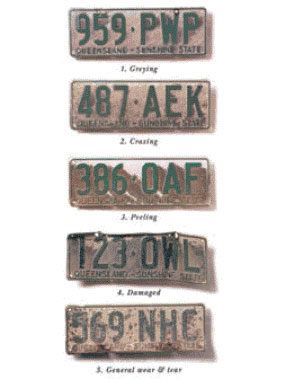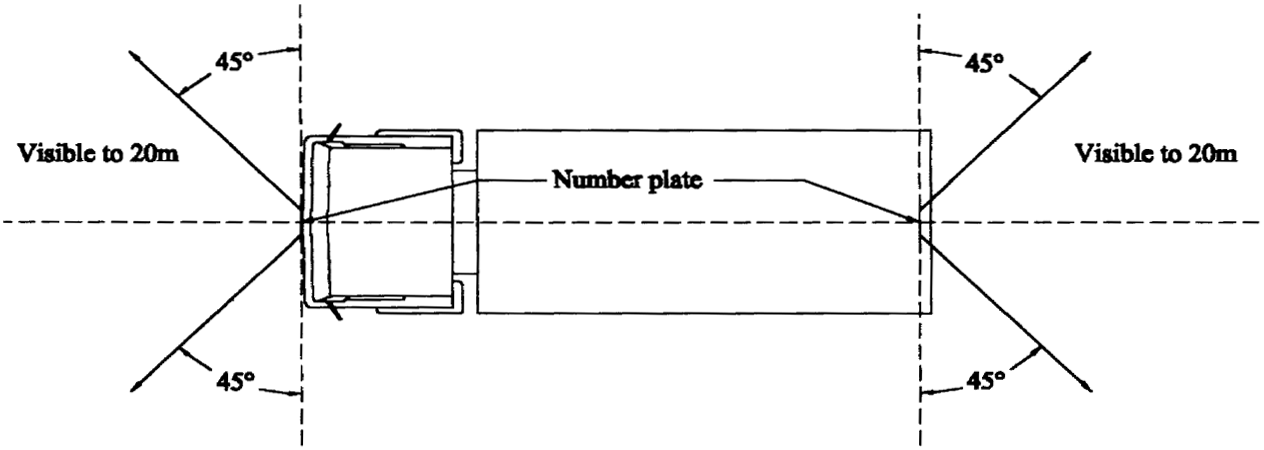Replacing or changing a number plate
- Requirements for number plates
- When to replace number plates
- How to replace number plates
- Replace illegal copies of plates
- How to attach personalised plates
- Items blocking your number plate
- Accessory plates
- Customised number plates
Requirements for number plates
If you drive on Queensland roads, you must ensure that each number plate issued to your vehicle is securely attached.
If your vehicle is issued with 2 number plates, 1 plate must each be attached to the:
- front of the vehicle
- rear of the vehicle.
If you are only issued with 1 number plate, for example motorbikes, the plate must be attached to the:
- rear of the vehicle.
It is the registered operator's responsibility to ensure number plates are attached.
It is important to note that any number plate issued to a vehicle, that includes personalised or customised plates, remains the property of the State of Queensland and must be surrendered to the Department of Transport and Main Roads, if required.
For personalised and customised plates, it is the number plate combination that is the property of the person to whom the plate is issued, not the physical number plate.
Find out more information about cancelling your vehicle's registration.
It is your responsibility to make sure your number plates are kept in good condition and are clearly legible from any position from which they are required to be visible.
Drilling holes in a number plate is only permitted:
- to enable it to be attached to a vehicle
- if the holes do not interfere with the appearance of any characters on the plate
- if plates are not altered in any way to damage or deface the plate.
Drilling holes in a plate to attach a reversing camera is not permitted.
If your number plates are fitted with a cover, plate covers must be:
- clear, clean and untinted
- flat on entire plate surface
- non-reflective.
A cover, which includes a frame, must allow for clear space around the plate details and not sit flush to any details, which includes the plate number and the registering state or territory.
Legible number plates are essential to ensure accurate identification of vehicles. This is based on a need to trace:
- stolen vehicles
- vehicles involved in crime or traffic incidents, such as red light and speed camera offences.
You can be fined if your plate details are not clear due to a drilled hole, cover or a frame or for not replacing damaged or illegible number plates.
The characters on a number plate must be visible from 20m away at any point within an arc of 45 degrees from the surface of the plate, above or to either side of the vehicle. Plates must not be more than 1.3m above ground level. This is shown in the diagrams below.
When to replace number plates
Over time, excessive exposure to exhaust fumes, chemicals, stones, the sun, and general wear and tear can damage your plates and make them hard to read. You should check the condition of your plates regularly, particularly if you have older plates.
Standard number plates have a 10 year warranty against faulty material and workmanship. This warranty period only applies when a vehicle is being used under normal conditions. For warranty information for standard or personalised plates, contact the department or go to a transport and motoring customer service centre or, if you live in a rural area, a QGAP office, Magistrates Court or local police station that provides vehicle registration services—please call to confirm before visiting.
Police and transport inspectors regularly check the condition of number plates. Make sure your plates can be read. If they cannot be read and cleaning does not fix the problem, you will need to replace them.
If a vehicle's number plates are stolen, the registered operator of a vehicle must advise the Department of Transport and Main Roads within 14 days after discovering the plates have been stolen. The theft of the number plates should also be reported to the Queensland Police Service. Similarly, if number plates are lost, damaged or destroyed, the registered operator of a vehicle must advise the Department of Transport and Main Roads within 14 days.

How to replace number plates
To replace your plates, whether you are replacing standard, personalised or customised number plates you can visit a transport and motoring customer service centre or, if you live in a rural area, a QGAP office, Magistrates Court or local police station that provides vehicle registration services—please call to confirm before visiting.
You will need to:
- bring your old plates (but do not remove them from the vehicle until you arrive at the customer service centre)
- fill in the:
- standard number plate/s replacement application (F3540) or
- personalised/customised plate/s replacement application (F3543)
or - replacement accessory number plate application (F5341)
- bring evidence of your identity:
- if the vehicle is registered in a business or company name, the person representing the company must have personal identification and provide evidence of representation, such as being in uniform or showing work identification
- if your vehicle with standard number plates is registered in 2 names, either person can sign to replace the plates and provide identification
- if personalised or customised plates are in 2 names, they must both sign the application and both provide identification.
- pay the fee:
- to replace standard plates with the same or a different plate number
- check PPQ for the fee cost of a personalised plate.
When you hand your form in, you will need to hand over your old plates as well. If you cannot hand over your plates (because they were lost, stolen or destroyed), you will need to explain on the form what happened to them.
If you are getting replacement plates that are not customised or personalised, you will get them immediately. You will get a new number plate combination. You must attach number plates within 24 hours of receiving them. We encourage you to attach the new plates to your vehicle before you drive away.
If you are applying for the same plate number (these are known as customised plates) or personalised plates, your new plates will be ordered and mailed to you. You need to keep the old plate on the rear of your vehicle until you receive your new plates. For a vehicle with 2 plates, keep the plate that is in the best condition on the rear of your vehicle. You must hand in the old plate when the new plates arrive.
Replace illegal copies of plates
If your standard number plates have been copied, we will replace them free of charge. Copied plates are illegal copies of your number plates that use your number and letter combination to avoid infringements.
If you suspect your number plate combination has been duplicated and used in illegal activity, contact Queensland Police and obtain a report stating you have been the victim of a copied plate offence.
How to replace your copied number plate
To get replacement plates, visit your nearest transport and motoring customer service centre and bring with you:
- your report issued from the Queensland Police
- your number plates (remove them after you arrive at the customer service centre).
How to attach personalised number plates
Information about attaching personalised number plates to your vehicle is available on the PPQ website.
Items blocking your number plate
If you have a tow bar on your vehicle that blocks the view of your rear number plate, remove it when you’re not using it. If your vehicle’s tray is in the way, move your number plate to where it can be seen easily.
A registered trailer is allowed to block the view of your vehicle’s number plates if the trailer’s plates are visible.
Accessory number plates
You are required to display an accessory number plate if you have a vehicle accessory such as a bicycle rack on your vehicle that blocks the view of your number plate. An accessory number plate ensures your number plate complies with visibility requirements.
An accessory number plate is not required if a registered trailer blocks the view of your vehicle’s number plates but the trailer’s plates are visible.
How to order an accessory number plate
You can order an accessory number plate:
- online from PPQ
or - in person at a transport and motoring customer service centre.
To order in person, you need to:
- complete the new accessory number plate application (F5341)
- bring evidence of your identity if:
- the vehicle is registered in a business or company name, the person representing the company must have personal identification and provide evidence of representation, such as being in uniform or showing work identification
- your vehicle with standard number plates is registered in 2 names, either person can sign to order an accessory plate and provide identification
- a personalised/customised plate is in 2 names, they must both sign the application and both provide identification
- pay the fee for an accessory plate for your standard or personalised number plate.
Customised number plates
You can customise number plates for a:
- motor vehicle
- national heavy vehicle number plate
- motorcycle
- special interest vehicle—green on white or black on white only
- large trailer
- small trailer.
You should customise number plates if:
- you want to keep the same number—if the plates need to be replaced
- a slimline plate is required (customising a currently issued plate)
- you want to get a plate number that was issued in the past but is no longer in use (retro/previously issued plates).
Customised plate rules
Customised plates can:
- only be attached to a vehicle registered in exactly the same name as the owner/s of the plate number
- be kept when you transfer your vehicle—you will need to replace them with standard plates before transferring
- be kept when you cancel your vehicle registration
- be attached to another vehicle registered in the plate owner/s name/s
- be upgraded to personalised plates (personalised plate rules apply).
Customised plates will become standard number plates if attached to a vehicle when transferred.
You can’t sell a customised plate as ownership is not transferable.





